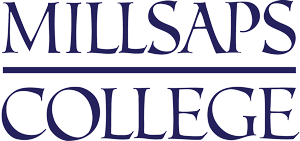Traditions
Millsaps has adopted many long-standing traditions since its founding in 1890. Along the way new traditions have been woven in to create vibrant and beloved traditions that enrich our campus community.
Alma Mater
The first Millsaps alma mater was written in 1907, by Dr. James Ailed Wamsley, who was the professor of history and economics. A second alma mater was written sometime around 1914. As the story goes, a Millsaps graduate was visiting the University of Missouri campus, where he heard their alma mater. He was so impressed by it that when he came back to Millsaps he sat down with his copy of the University of Missouri alma mater, and substituted “Millsaps” where “University of Missouri” appeared. This new version was presented to the student body and adopted.
The second alma mater is still used today, with some minor modifications made in 1985. “Loyal ones” in the second line of the first verse replaced “Loyal sons” and “man and woman” in the first line of the second verse replaced “man and maiden.” The current alma mater is:
“Alma mater, dear old Millsaps,
Loyal ones are we.
Our fond hearts are thine alone
And evermore shall be.
(Chorus)
Proud art thou, in classic beauty,
Of thy noble past.
With thy watchword Honor, Duty,
Thy high fame shall last.
Every student, man and woman,
Swell the glad refrain,
Till the breezes, music-laden,
Waft it back again.”
The Purple and White, October 8, 1942, page 5.
Campus Sculptures
Millsaps has three sculptures located across campus. A bronze sculpture of John Wesley, founder of Methodism, stands on the Millsaps campus thanks to members of the Classes of 1964, 1965 and 1966. These classes raised funds for the sculpture, and artist Ben Watts, Class of 1980, crafted the final product.
A sculpture of the Indian leader Mahatma Gandhi was unveiled in a November 2003 ceremony on the walk between the Ford Academic Complex and Sullivan-Harrell Hall. The sculpture, a gift of the India Association of Mississippi, honors a man who influenced the lives of millions through his philosophy of nonviolence and peaceful resolution to conflict. Students have established the tradition of fist-bumping Gandhi for good luck on tests.
A life-size sculpture of Eudora Welty sitting on a bench holding a copy of her Pulitzer Prize-winning 1973 novel, “The Optimist’s Daughter,” was dedicated in 2017. The commissioned bronze work was also produced by Ben Watts, a 1980 graduate of Millsaps who created the John Wesley sculpture that overlooks the Bowl. The Welty statue is a beloved feature on campus. Students have been known to dress her in a warm scarf and hat on cold winter days.
Building & Campus Features
There are several notable landmarks that give Millsaps’ campus its beauty and charm.

The Bowl & Potted Oak Tree
The Bowl, located in the center of campus, is at the heart of student life. Many events take place here, including annual commencement ceremonies and homecoming activities. Students often congregate here to study and socialize. In addition, the Bowl is the scene of activities fairs, open-air bazaars, and warm-weather picnics.
The large oak tree in front of the Boyd-Campbell Student Union is submerged in a massive brick cement flower pot. According to Dr. Ross H. Moore, a graduate of Millsaps and professor of history, when the student union was built in 1957, because of the contour of the land in that area, a great deal of earth had to be moved to what was then known as “Sullivan’s Hollow” to even begin construction. To simply pile that much dirt around the trunk of the old water oak surely would have killed it.
The oak is still thriving after many years in the wall. This shady location with built-in seats has been an important congregating place for students for decades. Many speeches have been given and many causes have grown under its protecting limbs. It has been a focal point of discussion and debate, not to mention many hours of idle talk and reflection as life in “the Bowl” continues.
Founders’ Tower
The Founders’ Tower is a 122-ft.-tall, copper-clad tower that recognizes the founders of Millsaps College and their generosity.
The tower’s base, constructed of brick and cast stone, contains bronze reliefs that depict the founders — Major Reuben Webster Millsaps, Bishop Charles Betts Galloway and Dr. William Belton Murrah.
Inscribed in marble below the reliefs are the names of those individuals and organizations who are members of the Founders Society, established in 1987 in recognition of those donors whose cumulative giving to Millsaps College totals $1,000,000 or more.
The gift for construction of the Founders’ Tower was made by McCarty Farms Inc., of Magee, Mississippi in honor of the Hyman F. McCarty, Jr., family. Built in 1987 as the centerpiece of a campus construction and renovation project, the tower houses a computer-controlled carillon and clock.


Millsaps Gateposts
The brick and marble gateposts were constructed in 1941, funded by the senior classes of 1939, 1940, and 1941. The 12-foot-high and three-foot-square pillars are topped with electric lights.
This historic campus landmark was dedicated on commencement day in 1941. They were originally placed on either side of the North State Street campus entrance. When this main entrance was closed in the late 1980s, the college placed the gateposts at the pedestrian campus entrance in front of the Millsaps Founders’ Tower.
Tomb of Major and Mrs. Reuben Webster Millsaps
Near the center of campus is the tomb of the college’s founder, Major Reuben Webster Millsaps, and his wife, Mary.
Constructed in 1914-15, the tomb was finished not long before his death in 1916. Mrs. Millsaps had died in 1908. The tomb has a stained glass window, chosen by the major, which features a setting sun.
The tomb was refurbished in the 1980’s, when the campus was re-landscaped. Campus folklore has persisted that Major and Mrs. Millsaps are no longer buried here, but this is untrue.


James Observatory
The James Observatory is a familiar campus landmark. It is the oldest building on campus, built in 1901 by Dr. Dan A. James in honor of his father, Peter, and brother Samuel. James, a pioneer Methodist preacher, entered Millsaps College in 1892 soon after its opening. James also built the original Kappa Alpha fraternity house in 1903.
The observatory is a red masonry building with solid granite capstones and lintels, surrounded by a white wooden catwalk. Atop the structure is its most outstanding feature, a wood and metal rotating dome. Inside is a 6-inch Warner-Swayze refracting telescope originally installed and state of the art in 1901. For many years it was the largest telescope in the state. A small powered finder telescope is attached to the larger one, as is a clock which turns the instrument as the Earth rotates so that an object will remain in focus. Mounted on a solid brick pillar constructed independent of the observatory floor and walls, and set deep into the ground, the telescope is protected from the vibrations of West Street traffic and observers in the building.
The James Observatory underwent major renovations during 1980 and in 2017, and it has been opened for the citizens of Jackson through the years for star-gazing and viewing Halley’s comet, eclipses, constellations and planets, and more recently, the Hale-Bopp comet.
The M Bench
In 1926, several students decided that there was a need for an area where students could gather between their classes to linger. So, the classes of 1926, 1927 and 1928 held a conference and settled on a plan to erect a bench located between Murrah Hall and the McRae Christian Center. It is now known to most students simply as the “M Bench,” having borrowed its name from the famous “C Bench” at the University of Chicago.
The romantic tradition of the “M Bench” is that the first person a Millsaps student kisses on the bench is the person they will marry. In warm weather, professors often use it as a classroom.
The Purple and White, October 29, 1948, page 3.

